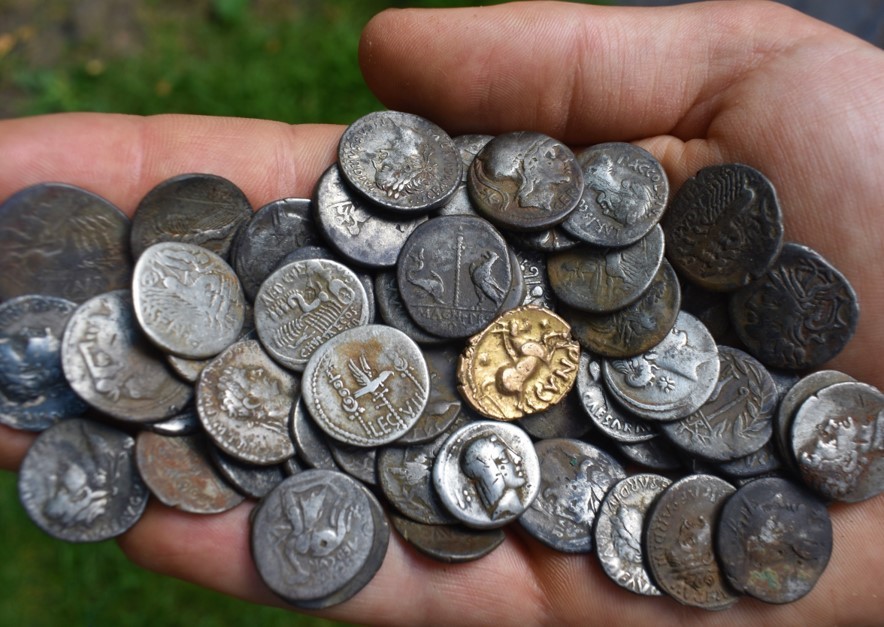Suffolk hoard of Roman coins at Noonans

A hoarde of Roman coins from the Claudian invasion of Britain, unearthed in the grounds of Helmingham Hall in Suffolk, will be offered at Noonans Mayfair on September 18 with an estimate of £75,000.

The collection comprises over 680 gold and silver coins dating from as early as 206 BC right up to the emperor Claudius in 46/47 AD, which will be offered by Noonans Mayfair on Wednesday, September 18, 2024.
The hoard was discovered by a metal detectorist George Ridgway in the grounds of Helmingham Hall near Stowmarket in Suffolk. George, who lives in the nearby village of Ashbocking, said: “It was on September 8, 2019, that I decided to investigate an unusual crop mark in a recently harvested barley field in Suffolk with my Garrett AT Pro metal detector. I knew that a Roman road ran close to the field and was hoping the two might be related, but after scouring the area nothing turned up.”

He continued: “I moved away 30 yards, and recovered two early Roman bronze Colchester type brooches dating from the mid 1st century AD. Another clear signal nearby from the detector then revealed a silver denarius, a coin that had been issued by Julius Caesar in 46 BC. I couldn’t believe that over the next three hours of searching, I found 160 more Roman silver coins, with a few of the coins stuck to pottery fragments. I knew I had made an important archaeological discovery and called my dad to guard the site overnight while we waited for an archaeological team to arrive and excavate the site. It took three months to recover the hoard.”

He finished: “It was then that Iron Age gold coins of Cunobelin, the king of the Catuvellauni and Trinovantes tribes started appearing. In total 748 gold and silver coins dating from as early as 206 BC right up to the emperor Claudius in 46/47 AD were uncovered. The British Museum and the Colchester & Ipswich Museum claimed a total of 63 coins for their collections, including an aureus of Claudius, for their collection.”

Alice Cullen, Coin Specialist at Noonans added: “This is one of the largest hoards containing both Iron Age coins and Roman coins found in Britain, with the latest coins of Claudius and those of Cunobelin in virtually as struck condition. The location of the hoard together with the date range suggests the coins may have been buried by a long serving Legionary soldier from the XX Legion, who were stationed at nearby Colchester. In 47 AD the East Anglian Iceni tribe rebelled after the Roman governor Ostorius ordered them to disarm, resulting in a fierce battle that was likely held at Stonea Camp in Cambridgeshire, which the Romans won. Is it possible our hoard was concealed by a victim at this conflict.”

George, aged 34, who has a long-time girlfriend, Ruby, a trained archaeologist, has 3 dogs and works for the family run butchers established by his grandmother. He commented: “I was inspired by my childhood hero Indiana Jones to start history hunting when I was 4 years old, and I dreamed of finding a Roman hoard since my grandmother bought me a metal detector for my 12th birthday. It was an awe-inspiring moment when I realised that I had found one!”
The proceeds from the hoard are being split between the landowner and George. When asked what George would like to do with the proceeds, he said “Firstly, I would like to buy my dad a pint!”
Among the highlights of the collection is a stater from the reign of Cunobelin AD 8-41, decorated with a prancing horse which is estimated at £3,000-4,000; while a Denarius of Gaius Caesar, better known as Caligula, dating from AD 37-38 decorated with a portrait of Agrippina is expected to fetch £2,000-£2,600 and a Denarius of Claudius from Rome, dating from AD 46-47 is estimated at £2,000-3,000.

